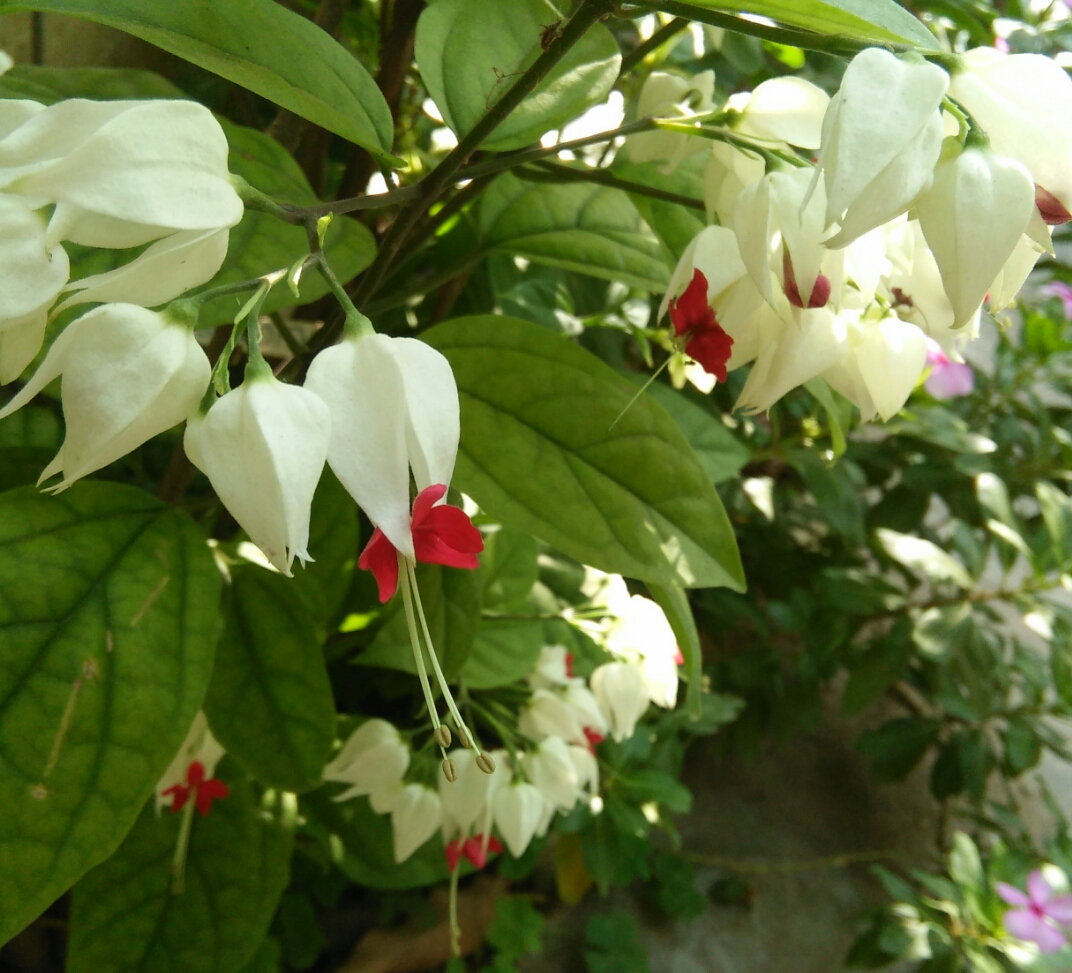Clerodendrum thomsoniae on:
[Wikipedia]
[Google]
[Amazon]
''Clerodendrum thomsoniae'' is a  The plant was named at the request of Rev. William Cooper Thomson (1829-22 March 1878), a missionary and physician in Nigeria, in honor of his late first wife. This plant was very popular during the mid 19th century under the name "beauty bush". It lost favour only when its unusual culture conditions were forgotten. Specifically, its root system must be partially submerged in water most of the time, and it wants very good light.
The plant was named at the request of Rev. William Cooper Thomson (1829-22 March 1878), a missionary and physician in Nigeria, in honor of his late first wife. This plant was very popular during the mid 19th century under the name "beauty bush". It lost favour only when its unusual culture conditions were forgotten. Specifically, its root system must be partially submerged in water most of the time, and it wants very good light.

''Clerodendrum thomsoniae''
*
thomsoniae Flora of Africa Garden plants Plants described in 1862 Taxa named by Isaac Bayley Balfour {{Lamiaceae-stub
species
In biology, a species is the basic unit of classification and a taxonomic rank of an organism, as well as a unit of biodiversity. A species is often defined as the largest group of organisms in which any two individuals of the appropriate s ...
of flowering plant
Flowering plants are plants that bear flowers and fruits, and form the clade Angiospermae (), commonly called angiosperms. The term "angiosperm" is derived from the Greek words ('container, vessel') and ('seed'), and refers to those plants th ...
in the genus
Genus ( plural genera ) is a taxonomic rank used in the biological classification of living and fossil organisms as well as viruses. In the hierarchy of biological classification, genus comes above species and below family. In binomial nom ...
''Clerodendrum
''Clerodendrum'' is a genus of flowering plants formerly placed in the family Verbenaceae, but now considered to belong to the Lamiaceae (mint) family. Its common names include glorybower, bagflower and bleeding-heart. It is currently classified ...
'' of the family
Family (from la, familia) is a group of people related either by consanguinity (by recognized birth) or affinity (by marriage or other relationship). The purpose of the family is to maintain the well-being of its members and of society. Idea ...
Lamiaceae, native
Native may refer to:
People
* Jus soli, citizenship by right of birth
* Indigenous peoples, peoples with a set of specific rights based on their historical ties to a particular territory
** Native Americans (disambiguation)
In arts and entert ...
to tropical
The tropics are the regions of Earth surrounding the Equator. They are defined in latitude by the Tropic of Cancer in the Northern Hemisphere at N and the Tropic of Capricorn in
the Southern Hemisphere at S. The tropics are also referred to ...
west Africa from Cameroon west to Senegal. It is an evergreen
In botany, an evergreen is a plant which has foliage that remains green and functional through more than one growing season. This also pertains to plants that retain their foliage only in warm climates, and contrasts with deciduous plants, whic ...
liana growing to tall, with ovate to oblong leaves cm long. The flower
A flower, sometimes known as a bloom or blossom, is the reproductive structure found in flowering plants (plants of the division Angiospermae). The biological function of a flower is to facilitate reproduction, usually by providing a mechani ...
s are produced in cymes of 8–20 together, each flower with a pure white to pale purple five-lobed calyx 2.5 cm in diameter, and a red five-lobed corolla 2 cm long and in diameter. The flowers are born in cymose inflorescence
An inflorescence is a group or cluster of flowers arranged on a Plant stem, stem that is composed of a main branch or a complicated arrangement of branches. Morphology (biology), Morphologically, it is the modified part of the shoot of sperma ...
s arising from the axils of the leaves. The leaves, in turn, are arranged opposite to each other and at right angles to the pairs above and below.
An unambiguous common name is bleeding glory-bower; terms like "glory-bower", "bagflower" or "bleeding-heart vine" are also often encountered but can refer to any of the roughly 400 species of ''Clerodendrum''. In some regions it has escaped from cultivation and become naturalised.
It is grown as an ornamental plant
Ornamental plants or garden plants are plants that are primarily grown for their beauty but also for qualities such as scent or how they shape physical space. Many flowering plants and garden varieties tend to be specially bred cultivars that ...
for its decorative two-coloured flowers. With a minimum temperature of , in temperate
In geography, the temperate climates of Earth occur in the middle latitudes (23.5° to 66.5° N/S of Equator), which span between the tropics and the polar regions of Earth. These zones generally have wider temperature ranges throughout ...
areas it requires shelter and a frost-free environment. This plant has gained the Royal Horticultural Society
The Royal Horticultural Society (RHS), founded in 1804 as the Horticultural Society of London, is the UK's leading gardening charity.
The RHS promotes horticulture through its five gardens at Wisley (Surrey), Hyde Hall (Essex), Harlow Carr (Nor ...
's Award of Garden Merit (confirmed 2017).

Etymology
''Clerodendrum'' is derived fromGreek
Greek may refer to:
Greece
Anything of, from, or related to Greece, a country in Southern Europe:
*Greeks, an ethnic group.
*Greek language, a branch of the Indo-European language family.
**Proto-Greek language, the assumed last common ancestor ...
and means 'chance tree'.Gledhill, David (2008). "The Names of Plants". Cambridge University Press. (hardback), (paperback). pp 111
References
External links
''Clerodendrum thomsoniae''
*
thomsoniae Flora of Africa Garden plants Plants described in 1862 Taxa named by Isaac Bayley Balfour {{Lamiaceae-stub